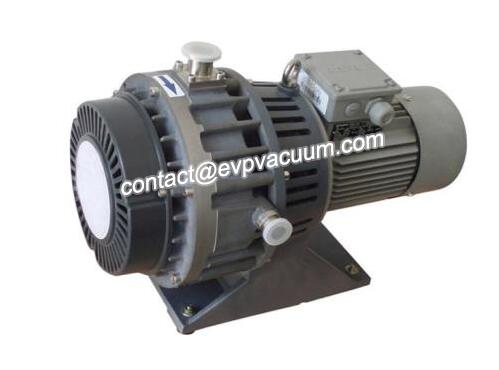How to select a vacuum pump suitable for laboratory use
Vacuum pump is the use of physical or chemical methods, the gas in the container out, so as to obtain lower than the atmospheric pressure device, the role of the vacuum pump is to obtain and maintain the vacuum.
Vacuum pump is widely used in metallurgy, chemical industry, food, medicine and other industries related to people’s livelihood.
In addition to industrial production and other fields, vacuum pumps are also widely used in various chemical and biological laboratories and other fields.
About the vacuum pump several concepts:
Vacuum: refers to the degree of low energy pressure and one standard atmosphere in a given space, commonly referred to as high vacuum and low vacuum.
Common vacuum units are Pa, Kpa, Mpa, atmospheric pressure, Kg (Kg/cm2), mmHg, mbar, bar, PSI, ATM, etc. The approximate conversion relation is as follows:
1 mpa = 1000 kpa
1 kpa = 1000 pa
1 standard atmospheric pressure =100KPa= 0.1mpa (approximate value, approximate calculation in the case of low requirements, for rough calculation)
1 standard atmosphere =1 Kg (Kg/cm2) (approximate value for rough calculation) =760mmHg
1 standard atmosphere =14.5PSI (approximate value, for rough calculation)
1 kpa = 10 mbar
1 bar = 1000 mbar
1 atmosphere =101325Pa (ATM represents one standard atmosphere as a reference)
Vacuum pump classification:
Classification by principle:
Gas transfer pump: as the name implies, gas transfer pump is a machine that transfers the gas in a closed space to the outside or other containers, so as to reduce the air pressure in the closed space and obtain a vacuum, such as water ring pump, oil-free plunger pump, rotary vane oil seal pump, etc.
Gas capture pump: it is a vacuum pump that adsorbs or condenses the pumped gas on the inner surface of the pump. Generally, chemical or physical chemical methods are used to reduce the gas volume so as to obtain a vacuum.
Classified by vacuum degree:
Crude vacuum: water ring vacuum pump used in industry and laboratory is this kind of crude vacuum pump, the general vacuum is 10E5~ 10e-1 Pa;
High vacuum: common oil seal pump of this class, the general vacuum is 10e-1 ~ 10e-6 Pa;
Ultra high vacuum: the gas capture pump is generally of this type, and the vacuum can reach 10e-6 ~ 10e-9 Pa.
Vacuum pumps for laboratory use?
There are two main types of vacuum pumps used in the laboratory: vacuum filtration and vacuum drying.
Vacuum suction filter is generally equipped with various laboratory vacuum filter devices, such as solvent filter, sand core filter bottle, brinell funnel filter bottle, bottle top filter, microbial limit detection filter device, multi-filter and so on. Simply said is the use of vacuum pumps, miniature vacuum pumps and other equipment to provide vacuum, so that the solid, liquid mixture, such as a separation speed. Vacuum filtration is often used in medical treatment, scientific research and other experiments, so in general, large vacuum pumps with huge volume, high noise and high power consumption are not suitable, the most commonly used are micro vacuum pumps and small vacuum pumps.
Vacuum drying is the use of low pressure liquid boiling point reduction, at room temperature that can be boiling evaporation, so that the sample to water or solvents and other substances, so as to achieve the sample concentration or crystallization method.
In the laboratory, the vacuum pump is generally used together with a variety of instruments, such as vacuum filter, waste liquid extraction instrument, rotary evaporator, vacuum drying box, freeze-drying machine and other equipment.
In the laboratory is the most used, the most important is oil-free piston type (mostly used for microbial testing) and corrosion resistance diaphragm type (mostly used for chemical laboratory), piston type and vacuum filtration, microbial testing, waste liquid extraction, vacuum drying box and other equipment supporting the use. Corrosion – resistant diaphragm type and rotary evaporator, vacuum drying box, centrifugal concentration and other supporting use.
Non-dry vacuum pump, such as oil vacuum pump, water cycle vacuum pump. Non-dry vacuum pump in common is that it needs the help of other materials (such as water and oil) to achieve the ideal vacuum degree, the most used in the laboratory is the oil rotary vane pump, generally and freeze-drying machine, vacuum drying box and other supporting use.
The first thing to know when you buy a vacuum pump for the role of the laboratory, such as vacuum filtration, vacuum drying. And whether the gas pumped by the vacuum pump can be corrosive, such as reagent purification, sample filtration. In general, oil-free vacuum pump can be selected for filtering samples, and corrosion-resistant vacuum pump can be selected for reagent purification.
Secondly from the vacuum pump configuration in other instruments and equipment consideration. If used for the configuration of rotary evaporator must use corrosion-resistant vacuum tube, spin evaporate volatile gas with a certain degree of corrosion; If it is used for drying box, you can choose a higher vacuum pump, such as rotary vane oil seal pump.


